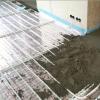Considered modern insulation for heating pipes, its types and features. Recommendations are given on the choice of heat-insulating material for hot water and heating systems. The properties of all possible heaters are listed.
Features of the choice of thermal insulation for pipes
Thermal insulation is used both for centralized heating mains and in-house heating networks in order to reduce heat losses. When choosing thermal insulation, it is necessary to take into account the diameter of the pipes, the temperature of the coolant and the operating conditions. The type of insulator to be used depends on the diameter of the pipes. These can be rigid molded cylinders, semi-cylinders, and soft mats in rolls.
Insulation of heating pipes of small diameter can be performed using cylinders, half-cylinders (equipped with grooves that create convenient and quick installation on pipes), also using segments made of polymer or mineral wool heat-insulating materials. They have very high thermal resistance. In addition, they have a low degree of water absorption, resistance to mechanical damage and a strict geometric size. Consider the scope of the most popular materials for thermal insulation.

Advice! Mineral wool is good for protecting heating network pipelines and pipelines with hot water supply in residential and public buildings, domestic premises, as well as pipelines whose surface is exposed to heat, such as chimneys.
Types of mineral wool
- Stone wool - is made from alloys of basalt rocks. She was mentioned above.
- Glass mineral wool - made from glass staple fiber, based on quartz sand, as well as broken glass. Such wool does not withstand high temperatures. It is also called glass wool, fiberglass.

Insulation of heating pipes is possible with the help of polyurethane foam material, which is used for thermal insulation of pipelines for a wide range of applications. However, the disadvantage of polyurethane foam is the relative high cost. The positive qualities include:
- resistance to atmospheric factors;
- non-toxicity;
- neutral smell;
- strength;
- the coating is not electrified;
- does not rot;
- resistant to plasticizer, solvent, acid and alkali;
- environmentally safe and does not have a harmful effect on the human body.

Products made of polyurethane foam are a rigid structure in the form of walls and ribs, which is produced under production conditions by pouring "pipe in pipe", which gives it strength and good thermal insulation properties. These structures are called heat-insulating shells. Reliable protection of the joints of pipelines from water is provided by a heat-shrinkable polyethylene tape, as well as a coupling of various brands of production.

Protective skin
In pipelines with rigid protective sheathing, pipes made of hot-dip galvanized sheet are used, having seams in the form of a spiral. Steel pipes in protective sheeting contain an insulating layer of polyurethane foam and are installed by ground laying. The positive aspects of such insulation include quick installation and dismantling, the likelihood of being used several times, and accessibility to pipeline sections with damage. If you still have not decided how to insulate the heating pipes, then you are presented with the following possible options.
Other foam insulation materials
There are a large number of foamed thermal insulation materials. These include various polymers such as foamed rubbers or polyethylene foam. Foam rubber pipe insulation is a flexible, closed-cell foam. Sold in the form of tubes and plates. They have increased fire resistance and are self-extinguishing materials. They do not rot, do not form fungi and mold, are resistant to water and condensation even at extreme temperatures.
Thermal insulation for polyethylene foam pipes
Thermal insulation for pipes made of foamed polyethylene is presented in the form of a tube with a technological notch with very precise technological diameters and wall thicknesses. It is resistant to moisture and temperature changes, has resistance to building materials such as cement, concrete, lime.

Styrofoam (styrofoam) insulation
It has low thermal conductivity and moisture absorption, does not change its properties for more than 50 years, therefore, in some industries it is an indispensable material for a wide range of temperatures. This insulation for heating pipes is made from two halves, connected by the thorn-groove method, thus not forming cold bridges. Polyfoam has an unlimited service life. It has good sound insulation and is difficult to ignite.

Penoizol - is not inferior in quality to polystyrene, being its close relative. It has the same properties as polystyrene foam. The advantage is that it is applied in liquid form, and as a result, the seams are tight.

Foam glass - consists of cellular glass, has good thermal insulation qualities, is completely safe. Foam glass has a high strength, does not shrink, is durable, does not burn at all, does not react to chemicals and their vapors. It is convenient for installation. Retains its properties for many decades. Not exposed to rodent infestation.

Thermal insulation paint
If, after all the options considered, you have not chosen how to insulate the heating pipes, then you should pay attention to another innovative material - heat-insulating paint. It has high thermal insulation properties, protects against corrosion, penetrates into hard-to-reach places, withstands both high and low temperatures. One layer of paint replaces mineral wool or polystyrene foam, thus reducing the thickness of the coating.

The use of materials is allowed only if there is an indexed link to the page with the material.

